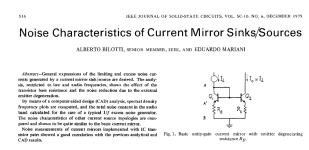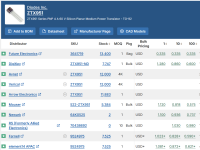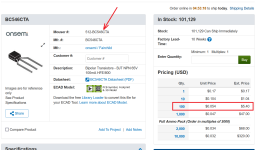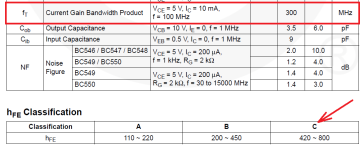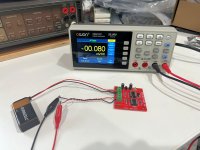I'm planning to make a discrete headphone amp with SSM2212 as input pair transistors, who has an extraordinary performance with hFE higher than 600 and 1nv/sqrt(hz) input noise.
However, if I use NPN SSM2212 as input pair, i may need another PNP pair as current-mirror at SSM2212's collector side, and another single NPN transistor as current-source at SSM2212's emitter side.
SO, if I cannot find the PNP pair and the single transistor with such a great performance as SSM2212, will them eventually make the whole input noise level higher, making it worthless to choose SSM2212 as input pair transistors?
However, if I use NPN SSM2212 as input pair, i may need another PNP pair as current-mirror at SSM2212's collector side, and another single NPN transistor as current-source at SSM2212's emitter side.
SO, if I cannot find the PNP pair and the single transistor with such a great performance as SSM2212, will them eventually make the whole input noise level higher, making it worthless to choose SSM2212 as input pair transistors?
How much gain is in the current mirror, second stage, etc, compared to the gain of the input pair? Then ask yourself how much more noise you can afford before you can see the contribution.
And then the Johnson noise of your feedback resistors can swamp everything out anyway…..
And then the Johnson noise of your feedback resistors can swamp everything out anyway…..
Frankly, I don't think it's necessary to spend a lot of effort squeezing the highest-possible SNR out of a headphone amp. It's the last stage in the signal chain. Your front end (MM/MC preamp, DAC, etc.) is going to have the largest impact on your overall system's SNR.
For a DIYer it's going to be the thing to do "just because" but the engineer in me is making me say this 🙂. Now I'm better.....
For a DIYer it's going to be the thing to do "just because" but the engineer in me is making me say this 🙂. Now I'm better.....
Fortunately you CAN find a PNP pair with better voltage noise than the SSM2212. Whether this is actually beneficial, or not beneficial at all, you can do it.
Bilotti's paper (snip attached) discusses the noise contribution of current mirrors. And of course lots of SPICE circuit simulators include a .NOISE analysis feature, so you can compare the simulated noise of your overall circuit with a transistor current mirror, versus your overall circuit with an ideal noiseless current mirror. IF YOU BELIEVE either Bilotti or SPICE, they may tell you whether it is actually beneficial to seek out and use ultra low noise PNPs to build your current mirror.
The spectacularly great, lowest voltage noise ever seen in a PNP, transistors are discussed in the 3rd edition of The Art Of Electronics by Horowitz and Hill. It's an excellent book that everyone who calls themselves a circuit designer should own. Part number is ZTX951, prices below.
It wouldn't be crazy at all, to make a decision like "Even though there is no theoretical benefit from using supremely low voltage noise PNPs in my current mirror . . . . . . I gotta use PNPs of some kind or another, and what's so bad about using PNPs that happen to be (needlessly) low voltage noise? Nobody gets hurt, I feel better that I picked the best possible parts, and oh by the way, they're not very expensive according to octopart.com so I'm not squandering giant piles of cash"
_
Bilotti's paper (snip attached) discusses the noise contribution of current mirrors. And of course lots of SPICE circuit simulators include a .NOISE analysis feature, so you can compare the simulated noise of your overall circuit with a transistor current mirror, versus your overall circuit with an ideal noiseless current mirror. IF YOU BELIEVE either Bilotti or SPICE, they may tell you whether it is actually beneficial to seek out and use ultra low noise PNPs to build your current mirror.
The spectacularly great, lowest voltage noise ever seen in a PNP, transistors are discussed in the 3rd edition of The Art Of Electronics by Horowitz and Hill. It's an excellent book that everyone who calls themselves a circuit designer should own. Part number is ZTX951, prices below.
It wouldn't be crazy at all, to make a decision like "Even though there is no theoretical benefit from using supremely low voltage noise PNPs in my current mirror . . . . . . I gotta use PNPs of some kind or another, and what's so bad about using PNPs that happen to be (needlessly) low voltage noise? Nobody gets hurt, I feel better that I picked the best possible parts, and oh by the way, they're not very expensive according to octopart.com so I'm not squandering giant piles of cash"
_
Attachments
Last edited:
There are other reasons to consider the SSM2212 pair, even if its noise performance is unlikely to produce a noticeable improvement in your HA's performance. Its well-matched transistors can help with regard to input offset voltage. Thermal effects are minimized. The high GBW doesn't hurt, either.Frankly, I don't think it's necessary to spend a lot of effort squeezing the highest-possible SNR out of a headphone amp. It's the last stage in the signal chain. Your front end (MM/MC preamp, DAC, etc.) is going to have the largest impact on your overall system's SNR.
For a DIYer it's going to be the thing to do "just because" but the engineer in me is making me say this 🙂. Now I'm better.....
There are plenty of high-quality amplifiers that use individual transistors in the front end -- but the transistors often are selected to match. Avoiding the necessity of buying a bunch of transistors to cobble up some matched pairs is definitely something to consider...
You will find there are many more "knobs" to adjust in any design you find or devise, and they can have a profound effect on your amplifiers's overall performance, too. Look at it as a learning experience and enjoy the trip!
To answer the question in the title, usually the input pair transistors.
The ultramatched pairs used in my example design presented at Burning Amp, cost $5.46 for a bag of 100 parts. In an hour of testing you can get 5 or 6 pairs of matched devices, whose Vbe's differ by less than 0.5 millivolts.
_
_
Attachments
Don't forget that a little emitter degeneration in the current mirror reduces the effective transistor Gm and therefore
the current mirrors contribution to the input noise. It also increases the mirrors output impedance. Current matching can also improve assuming well matched resistors.
the current mirrors contribution to the input noise. It also increases the mirrors output impedance. Current matching can also improve assuming well matched resistors.
There was a long discussion about this in one of the Blowtorch threads. Optimally degenerating the mirror reduces its noise contribution. You could check this out with a noise sim of your circuit in LTspice.
That said, I agree with Mark ‘51 - the HP amp features way down on the list of things to worry about noise wise.
That said, I agree with Mark ‘51 - the HP amp features way down on the list of things to worry about noise wise.
- Home
- Amplifiers
- Solid State
- Which affects input noise level most, input pair transistors or current-source transistors?
